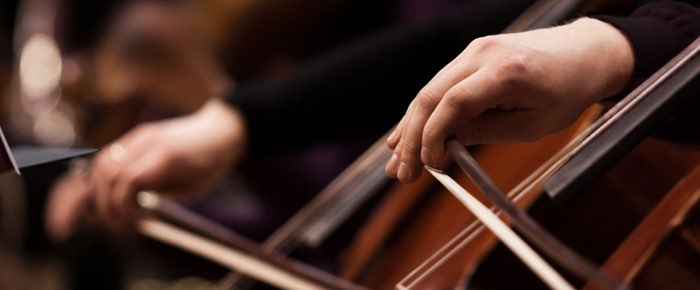The Des Moines Symphony Orchestra, celebrating its 85th season in 2022-2023, is one of Iowa’s and the Midwest’s premiere arts institutions. Led by Music Director Joseph Giunta for the past 34 years, the Orchestra has established an outstanding national reputation as one of the country’s leading regional orchestras. In 2016, the Orchestra was hailed by Phillip Nones of Bachtrack as “dazzling, with the Des Moines brass bursting forth with stentorian power...” and delivering a “soul-satisfying triumph.” The Orchestra performs a regular series of Masterworks, Pops, Family and Education Concerts, as well as performing for special events. With the establishment in 2003 of the Des Moines Symphony Academy, the organization is one of only five American orchestras to sponsor an Academy of Music as an integral part of its core mission.
The Symphony, a founding member of the League of American Orchestras in 1942, is the principal resident company of the 43-year-old, acoustically acclaimed 2,662-seat Des Moines Civic Center. The Symphony performs seven pairs of Masterworks concerts there each season, which have included the major works of the orchestral repertoire and collaborations with some of the music world’s most prominent soloists including John Browning, Van Cliburn, Alicia De Larrocha, Simon Estes, Sherrill Milnes, Itzhak Perlman and Yo-Yo Ma, and in 2011, the Martha Graham Dance Company in a special Des Moines Performing Arts presentation.
Under the leadership of Joseph Giunta, the Orchestra received the Bravo Greater Des Moines Encore Award for offering a well-received, highly creative and diverse mix of programming; including commissions and world premieres of 25 new works during the last 29 years. The Orchestra and Joseph Giunta together received the League of American Orchestras’ prestigious ASCAP Award for Adventurous Programming in recognition of their commitment to contemporary music.
Recently, Joseph Giunta and the Des Moines Symphony commissioned Symphony in Sculpture I, II, & III, works inspired by the John and Mary Pappajohn Sculpture Park and written by Emmy Award-winning composer Steve Heitzeg. DVDs of Symphony in Sculpture I, II, & III, featuring multi-track, five-channel, surround sound recordings of the pieces accompanied by original films created by Blur MediaWorks, plus a behind-the-scenes making-of documentary, were released 2013, 2016 and 2020 respectively. In August 2016, the Des Moines Symphony accepted an invitation by the Iowa State Blue Ribbon Foundation to perform Peter Hamlin’s Symphony On A Stick on the opening night of the 2016 Iowa State Fair – the very event which had inspired its commission by the Symphony in 2015.
In addition, the Orchestra performs a Pops series, including its annual New Year’s Eve Pops at the Civic Center, and has collaborated throughout its history with some of the leading popular artists of the day including Ella Fitzgerald, Roger Williams, Audra McDonald, Kristin Chenoweth and Leslie Odom, Jr., among others. In July 2019, the Symphony launched a free summer series, Water Works Pops, at the newly built Lauridsen Amphitheater at Water Works Park. The organization also produces and performs the much anticipated free, annual Des Moines Symphony’s Yankee Doodle Pops concert in July on the grounds of the Iowa State Capitol; attracting some years more than 100,000 listeners, the largest single-day attendance of any concert event in the State. All of the Orchestra’s Masterworks programs are broadcast statewide on Iowa Public Radio Classical, the radio home of the Des Moines Symphony, and the Orchestra can be heard on several compact disc recordings with Joseph Giunta conducting, including a collection of all nine Beethoven symphonies recorded as a unique series, and on the Chesky Records label with acclaimed American pianist Earl Wild.
Music education has always been an important commitment, and in 2003, the Des Moines Symphony inaugurated the Des Moines Symphony Academy, housed in the beautifully restored 1913 former Masonic Temple building in downtown Des Moines now called The Temple for Performing Arts. The Symphony Academy is a year-round institution dedicated to providing outstanding music education opportunities for students ages three to adult including private lessons, group classes, chamber music and four outstanding Des Moines Symphony Youth Orchestras, which attract more than 600 accomplished young instrumentalists from throughout Central Iowa each week. The Academy’s annual Fred & Charlotte Hubbell Visiting Artist In Residence Program has hosted violinist Midori, composer Andrew Norman, Symphony Concertmaster Jonathan Sturm, among others, and “Maestro Classes” with guest conductors Jahja Ling, Peter Oundjian, Gerard Schwarz, Christopher Seaman, and JoAnn Falletta. The Academy has continued its outreach by establishing partnerships with Waukee, Urbandale, Ankeny and Johnston School Districts and West Music to provide on-site and group lesson instruction. In addition, the Des Moines Symphony performs its school-day Youth Concerts for more than 5,000 schoolchildren each year at the Civic Center.


